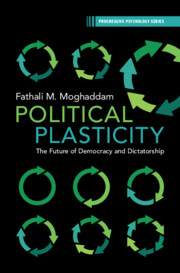Book contents
- Political Plasticity
- The Progressive Psychology Book Series
- Political Plasticity
- Copyright page
- Dedication
- Contents
- Figures
- Preface
- Acknowledgments
- Chapter 1 Political Plasticity, the Key to Understanding the Future of Democracy and Dictatorship
- Chapter 2 Hardwiring inside and outside People
- Part I Political Plasticity and Behavioral Continuity
- Chapter 3 Why Do Leaders Still Exist? Leadership and Followership
- Chapter 4 Rich and Poor – Still Just as Different
- Chapter 5 Ethnicity Is Forever
- Chapter 6 Religion, Eternally Present but with a Thousand Faces
- Chapter 7 The Built Environment and Behavioral Continuity
- Part II Change Agents, in Theory and Practice
- Part III Looking Ahead
- Notes
- References
- Index
Chapter 3 - Why Do Leaders Still Exist? Leadership and Followership
from Part I - Political Plasticity and Behavioral Continuity
Published online by Cambridge University Press: 15 January 2023
- Political Plasticity
- The Progressive Psychology Book Series
- Political Plasticity
- Copyright page
- Dedication
- Contents
- Figures
- Preface
- Acknowledgments
- Chapter 1 Political Plasticity, the Key to Understanding the Future of Democracy and Dictatorship
- Chapter 2 Hardwiring inside and outside People
- Part I Political Plasticity and Behavioral Continuity
- Chapter 3 Why Do Leaders Still Exist? Leadership and Followership
- Chapter 4 Rich and Poor – Still Just as Different
- Chapter 5 Ethnicity Is Forever
- Chapter 6 Religion, Eternally Present but with a Thousand Faces
- Chapter 7 The Built Environment and Behavioral Continuity
- Part II Change Agents, in Theory and Practice
- Part III Looking Ahead
- Notes
- References
- Index
Summary
A central feature of human societies is the continued reliance on individual leaders as decision-makers, particularly at the national level. In the vast majority of cases throughout human history, in major societies these leaders have been male. Even in the age of the electronics revolution, when decision-making could potentially be through mass participation, the United States has moved closer to an imperial presidency and the leaders in China and India, the most populous countries in the world, are male and have become more dictatorial. The evolution of centralized individual male leadership is discussed in this chapter as arising from the development of a surplus and the emergence of private property. These developments led to wealth concentration and group-based inequalities, with the leader being a member of the power and wealth elite. Some animal groups practice collective decision-making, but for the most part decision-making in human societies continues to rely on individual (often older) male leaders.
Keywords
- Type
- Chapter
- Information
- Political PlasticityThe Future of Democracy and Dictatorship, pp. 25 - 36Publisher: Cambridge University PressPrint publication year: 2023

